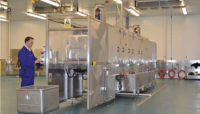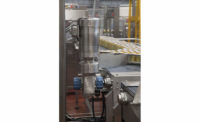Spray ’n’ wash
New antimicrobial dips and sprays are available to help poultry and beef processors fight pathogens.

Did tougher food-safety regulations lead to advances in antimicrobial applications over the last year? It seems so, as poultry and beef processors experimented with new chemical combinations in their dips and sprays as part of an overall effort to reduce pathogens.
Last summer, the U.S. Department of Agriculture’s Food Safety and Inspection Service (FSIS) tightened its Salmonella and Campylobacter performance standards for poultry processors, as these foodborne pathogen levels were above the Healthy People 2010 targets.
According to the FSIS, Salmonella levels must be below 7.5 percent (instead of 20 percent) and Campylobacter must be below 10.4 percent on processed chicken carcasses and 0.79 percent on turkeys.
“The new FSIS regulations caused some uncertainty at first for poultry processors, but they’ve learned to make adjustments,” says S.F. (Sarge) Bilgili, professor and extension scientist, department of poultry science, Auburn University. “Poultry suppliers are always working to control Salmonella, so those methods haven’t changed substantially, but the methods that work with Salmonella don’t really reduce Campylobacter, which is always a real curve ball.”
Barge notes that Campylobacter can be targeted more effectively on the live production side before birds reach processing plants. “Campylobacter is fragile, and can be destroyed through water-treatment systems and doesn’t survive freezing very well,” he notes.
The key appears to be using different chemicals for spraying and dipping carcasses and primals/subprimals for each stage of the slaughter process.
“Most plants use chlorine on product and non-product contact surfaces via FSIS regulations on carcass washes and chillers, and some plants also use chlorine on the automated lines,” he says. “Every company uses antimicrobials based on cost and volume; I can’t say what the best control combination would be for each plant, because they are all unique.”
That’s why effective management practices are commonly thought to lay the foundation for safe products, says Ashley Peterson, Ph.D., vice president of scientific and regulatory affairs, National Chicken Council.
Replacing chlorine?
“Intervention technologies and applications have been widely adapted and introduced into the slaughter and processing process over the last decade,” she says, citing several approved antimicrobial chemical rinses, dips and washes to reduce contamination within a process as examples.
“These approved antimicrobials offer an alternative to chlorine and have demonstrated to be more effective than chlorination when used at key intervention steps in the process,” she says, “for example, pre- and post-chill sprays and dips, chiller, scalders, IOBWs [Inside-Outside Bird Washer], and rinses and dips in further processing, to name a few.”
According to Peterson, chlorine is being used less or not at all by some plants primarily because of trade-related concerns, “but it still plays an important role in many other plants as a safe and effective food-safety intervention, often as a complement to other interventions.”
Several technologies and prerequisite programs for recirculation and water reuse have been introduced and implemented by poultry processors in recent years, she adds.
“This has been driven by the need to conserve water resources, reduce effluents and improve wastewater treatment which has benefitted industry, municipalities and public, and general good stewardship of the environment,” she says.
Attacking pathogens, naturally
The beef industry has recently experimented with antimicrobial sprays and dips that utilize biocontrol, or the principle of biopreservation, to offer a more prolonged antimicrobial impact. Processors can now use microorganisms to antagonize or inhibit the growth of pathogens on food products, such as Lactic Acid Bacteria that is traditionally used in the fermentation of foods like cheeses and sausages.
“These organisms exert antimicrobial activity by competing with pathogens for nutrients present in the food — for example, protein, sugar, minerals, etc. — and by the synthesis and secretion of compounds that have inhibitory activity, including things like organic acids, and antimicrobial polypeptides,” says Matthew Taylor, Ph.D. assistant professor, food microbiology, Texas A&M University.
He notes that the USDA currently allows three such commercially available products for use on various meat and poultry products.
Another example of biocontrol is the use of what are called bacteriophages — viruses that infect and kill bacteria. These have actually been in use as disease therapies for over a century in the U.S. and Europe, but in recent years the Food and Drug Association (FDA) and USDA have begun to allow a select number of products containing these viruses for use as food antimicrobials, he says.
“Food-safety microbiologists have given increased attention to them in recent years because they can, under certain conditions, continue to exert inhibitory activity against pathogens on foods long after chemical preservatives have exhausted their efficacy or have been degraded,” says Taylor. “However, their true utility within the framework of food processes has yet to be fully quantified, and so research is ongoing.”
In the end, debate still remains over how much food-safety protection these types of antimicrobials actually offer to consumers.
“Chemical antimicrobials such as lactic acid, chlorine, nisin, lysozyme and other antimicrobials provide the benefit of rapid, significant reduction in the numbers of bacterial pathogens on foods that are generally not observed with biopreservatives,” he says. “However, as I mentioned before, biocontrol products can offer the opportunity for a more prolonged antimicrobial impact.”
One improvement that has been researched by multiple scientists is the opportunity to reduce the volume of antimicrobial applied to a food product or animal carcass without sacrificing the observed pathogen reduction.
“Some researchers have observed that when some antimicrobial solutions are electrochemically charged by the introduction of electrons and then sprayed on to a food surface with an electrostatic spray device, there tends to be a reduction in the amount of antimicrobial applied necessary to provide adequate product coverage,” says Taylor.
The reduction in water usage in food processing is an area of concern for the beef industry as well. Researchers are looking for ways to gain the same level of antimicrobial efficacy, or sanitation efficacy, while using less water to prevent pathogen contamination and increase conservation.
Due to consumer concerns over the accumulation of some food facility sanitizers or food antimicrobials in the water supply, groundwater or soils, researchers are experimenting with natural antimicrobials, he adds.
Several natural antimicrobials, including the organic acids, antimicrobial polypeptides like nisin that have no adverse effects on consumers, enzymes like lysozyme and lactoferrin (sourced from egg white and fluid milk, respectively) and even essential oil compounds derived from spice plants (such as essence of clove, cinnamon and garlic), says Taylor, are being researched as alternative pathogen-control methods.
“These naturally occurring compounds are functional, non-toxic and biodegradable,” says Taylor. “The problems often rest in purification and refinement of antimicrobials, the cost of use and the impacts of such compounds — especially spice-derived compounds — on the food product’s organoleptic properties.”
In other words, will consumers accept oregano-infused orange juice? Probably not, but scientists are working on embedding these compounds so they fight bacteria without leaving a taste.
Looking for a reprint of this article?
From high-res PDFs to custom plaques, order your copy today!









